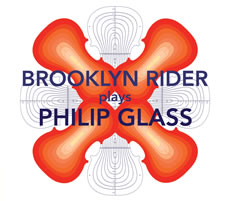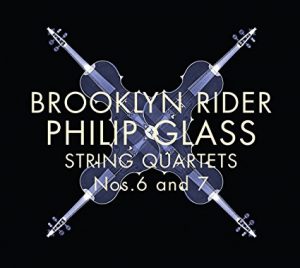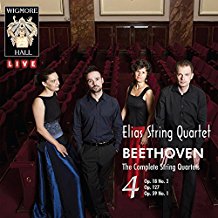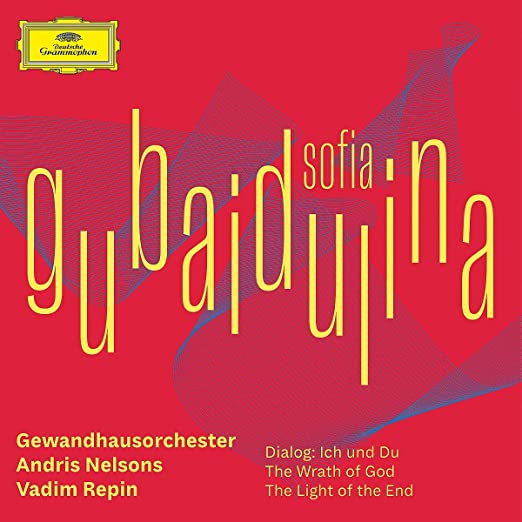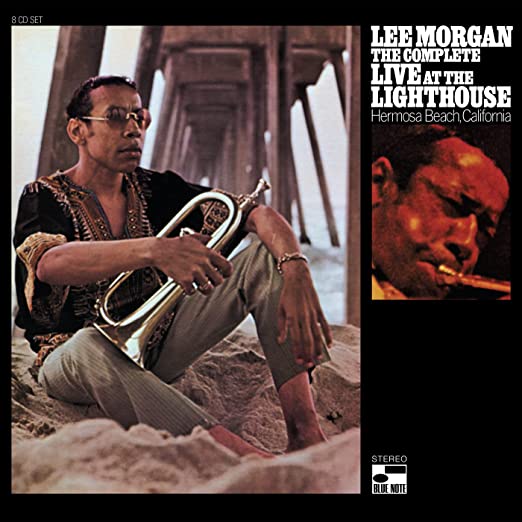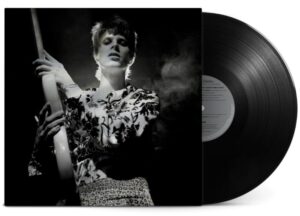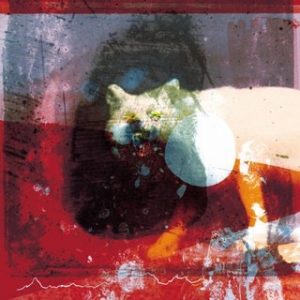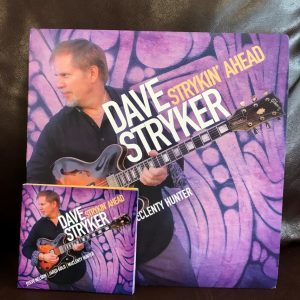Brooklyn Rider plays Philip Glass; String Quartets Nos. 1-5. 2 CDs. Orange Mountain 0074.
I didn't get the string quartets of Philip Glass at all until I began to hear them as informed by dance—all kinds of dance. The opening work on the album, Suite from Bent (1997), adapted for string quartet by the Brooklyn Rider quartet, moves from 4/4 to 3/4 to 2/4 as invisible dancers whirl about before us. I'd never seen them before! We don't ask dance music to give us a narrative. How much of minimalism would sound less unmusical and repetitious to us if we came to it as dance? And then what do we 'do' when the time signatures seem to play against each other? Two dancers, one taking long arching strides in 4/4 behind another who prances in 2/4. And then the slower dancers go to 3/4 and the faster ones to 2/4. Is this rhythmic counterpoint? Forgive all of this amateur chatter but after years of being put off by this music, it is finally coming to me. I have concluded that many of us come to minimalist music with the wrong expectations, so it has to fight its way through to us as we try to fend if off. Speaking for myself.
The Suite from Bent, movement 7 of 8, surprised me by slipping into a chant-like passage that carries us into the final movement with a long, plaintive line that then carries the work to its conclusion. I have now listened to this work four times and it has finally got through.
Another way of listening to this music is to hear it as modern use of the pedal point. In traditional classical music, the pedal point is a repeating pulse, usually in the bass line, beneath and behind melodic material in the foreground. In minimalism, the pedal point generally moves into the foreground, where it becomes much of the point. You listen through it to a moving melodic line that without it would be very nearly nothing at all. The moving line behind the pulsing foreground can become mesmerizing.
Listening to several of the string quartets of Glass in succession can be like watching a contemporary visual artist doing a series of paintings or prints that will eventually comprise variations on a single visual theme...or style. I suppose we could say that about most composers, but the pulsing, pedal point style of Glass brings this idea forward. We are listening to the exploration of a particular, fairly narrowly conceived style. So we begin to look and listen for differences. Or we just go with the project, dance to the music, noticing eloquent pauses, side glances. I wrote these notes while listening to both the Suite from Bent and Quartet No. 3, which appear ahead of the earlier and later works on this CD, so I've gotten ahead of myself.
String Quartet No. 1 (1966) starts out as what I would consider meditative minimalism. A repeating but uninsistent pulse moves from 4/4 to something irregular, marked by pauses. The first of its two parts borders on ambient music. The work actually feels as if it's written in paragraphs with moments of silence between them. Several of the paragraphs are more forceful but they are not the controlling ones. The second part feels as if we are reaching tentatively into the dark to see what can be found there. We are in the “Upside Down” (!) Toward the end of part two, the ambient quality of the work takes on a measure of forcefulness but it's too late to change the cumulative atmosphere significantly. The quartet then simply breaks off. Exercise done. As the composer's first foray into the form, Quartet No. 1 has the feel of an experimental one. But not an uninteresting one.
Quartet No. 2 (1983). We are dancing in 3/4 in the first movement, then more vigorously and fleetly in movement 2. You really could waltz to this music but you'd have to be truly light of foot—and by movement 3 we're off the ground.
Quartet No. 4 (1989). We can (almost) hear a melodic narrative running through and under the pulsing foreground of this quartet, which turns into a cello scurrying along behind the...foreground. The second movement insists on something like a narrative. The background now is the cello and viola while the two violins sing something plaintive to us—and then the pairs reverse roles. This remains recognizably Glass world but here it is reaching out a little. Glass world is not just an oeuvre, it is a spell we are asked to remain under, even when we are permitted to peek out. And then in the third movement we hear, if only for a moment, a descending melodic line, which, though it is almost immediately plowed under, plants a seed that blooms several moments later into a true melodic narrative—alongside the usual pulse/pedal point. This is not something we notice in these terms as listeners, it is what we notice when look for something to say! What we hear is music struggling to be music, recognizably melodic music. There is struggle going on here, and soon the melodic line and pulse are working together. And the descending melodic figure returns in the end to confirm this.
Quartet No. 5 (1991). Again, why do we (I) have so much more trouble with the repetition that characterizes minimalism than we (I) do with it in rock music, dance music, etc.? If it were presented to us as a branch of progressive rock, would we accept it more readily. On ECM?! String Quartet No. 5 offers a more complex listening experience than its predecessors. More is going on melodically to begin with, but most of it is still based on repeating figures and pulses. Moving into its fifth and final movement, we move pretty far away from the minimalist style for extended periods. The conclusion toys with us stylistically and effectively.
Brooklyn Rider, Philip Glass, String Quartets Nos. 6 and 7. Orange Mountain 0221.
All of this in preparation for the release of Glass's most recent work, Quartets Nos. 6 and 7, which were what brought me to this project. What if anything has changed in the musical world of of Philip Glass in the twelves years since Quartet No. 5?
In Quartet No. 6 (2013), not a great deal. There is more drama in the first movement than we are used to from the composer. And there are longer lines in the second movement, as the bass line weaves a pattern, making the repeating pulse less conspicuous. By the third movement things have nearly become rapturous! That said, we are still squarely in Glass world. If we've become happy here by now we feel no urgency to leave, and perhaps have even developed some curiosity about whether this thicker and more rapturous sound suggests new directions.
Quartet No. 7 (2014) in one movement begins in this richer atmosphere of long melodic lines, the characteristic pulse now more wavelike. The pace picks up a bit as we move further into the work and then the waves once again become pulses. Clearly, Glass has no intention of changing his colors, just likes to play with them; and by mid-movement we are largely closer to his 1980's sound. It is a more dramatic, more melodic version of his earlier work but again, clearly for him, home is a good enough place to be. I like Quartet No. 7 a lot. As with his recent cello sonatas, I have the sense that his minimalist pulses no longer play the dominant role. The music is using them for its own purposes.
I feel no need for a conclusion to this already over-long review. My goal has been mainly to describe what this music is like in the hope that, like me, you might feel called to try it out. The Brooklyn Rider string quartet are really fine musicians who seem to have a fine feel for Glass. Have fun.
Elias String Quartet, Beethoven, The Complete String Quartets, Volume 4. Wigmore Hall LIve WHL 0089/2. 2 CD's.
The 'European' way to play Beethoven is to remember where he came from. The young (1998) British Elias Quartet's musicians have been mentored by Europeans, and while they put their own stamp on the composer, we can hear their influence. They chose well: Alban Berg Quartet, Kürtag, Takacs-Nagy, and Dutillieux, among others. This volume 4 is a fine place to be introduced to the Elias Beethoven cycle, as it is made up of three quartets from the composer's three well-defined periods, early, middle, and late.
To remember where Beethoven came from is to play him in the context of the mid/late eighteenth century European classical tradition, emphasizing the music's verve, elegance, and restraint rather than focusing primarily on its originality. This approach is expectedly more evident in Opus 18, No. 2 (1798-1800) which opens the 'live' program. The Elias play it more beautifully than I've heard in a long time. It is sometimes a delight not to hear early Beethoven through our experience of the composer's later, more idiosyncratic quartets. The Elias remind us that Opus 18 can stand wonderfully on its own merits, as if the later quartets had never been written. But they apply just enough vigor to the work's natural elegance to remind us that while Haydn and Mozart are present, there is a new, young voice here with them.
Opus 59, 1 (1804). The Elias interpretation of this middle period quartet features a trace of legato that, as with the elegance and restraint of their Opus 18 performance, plays down the drama of the work a bit and provides in its place a sense of flow. This does not change the work we are used to but reminds us how much shear beauty the iconoclastic composer had in him, is in his music. And when the drama and contrast come—this is Beethoven—they do not burst upon us: they simply arrive as a natural outgrowth of the calmer waters that proceed them.
This is Beethoven that is never over, rather it expands and takes on meaning. We find ourselves returning to it time and again, looking for the secrets of its eloquence. Why have I not heard about these people before? They are truly wonderful. What their approach makes clear is that gifted musicians' individual excellence can sometimes be lost in the bolder ways of playing this music.
Opus 127. So how will the late quartet, Opus 127 (1824-25) take to the Elias approach? With the Elias, the drama, when there is drama, is in the music: it need not be added. Their Opus 127 has a judicious trace more starch than their Opus 18 and Opus 59 performances, just enough to keep Schubert at bay, waiting in the wings. Some will call this Beethoven Lite. The third movement Scherando is practically a Viennese waltz, though Beethoven syncopation saves it. The Elias dig into the accented beats with gusto, carrying the waltz on into 2/4 as the composer calls them to it. This is the movement that leads us into the late Beethoven style, and the final movement's sparkling and driving dissonances. This movement could be played as if it were the real and only Beethoven; but like their performances of his earlier quartets, the Elias 'remember' where this music comes from and let us hear the elegance of the earlier music within the ground-breaking turn of the composer's late style coming into being. Elegant forcefulness, vigorous beauty. To my ears, they get Opus 127 right.
Time to pursue Volumes 1-3 of their series and welcome these newcomers to the Beethoven stakes.
System used for this audition: Resolution Audio Cantata 3.0 CD player w/BlackJack power cord; Blue Circle 002I solid state integrated amplifier; JM Reynaud Offrande Supreme, V2 loudspeakers; Crimson interconnects and speaker cable; Mapleshade Samson equipment rack.
Bob Neill, a former equipment reviewer for Enjoy the Music and Positive Feedback, is proprietor of Amherst Audio in Western Massachusetts which sells equipment from Audio Note (UK), Blue Circle (Canada), Crimson (UK), Jean Marie Reynaud (France), Resolution Audio (US), and Tocaro (Germany).




